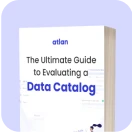Augmented Data Quality: Features, Benefits, and How It Works
Share this article
Traditional data quality processes simply can’t keep up with the sheer volume and complexity of data that modern business now demands. As a result, augmented data tools have emerged that are capable of processing and managing these massive datasets across multiple systems and formats. They are also becoming critical for maintaining data quality.
Unlock Your Data’s Potential With Atlan – Start Product Tour
Technologically enhanced data tools identify potential data quality issues before they impact business operations. By learning from historical patterns and detecting subtle anomalies, augmented data quality systems can predict where data quality problems are likely to occur and automatically implement preventive measures. These benefits (along with other data quality improvements) increase over time as the tools learn and adapt to your specific data environment and business goals.
This guide will teach you what augmented data quality is and how it works. We will explore the specific benefits of adopting augmented data quality practices, and where tools like Atlan come into play.
Table of Contents #
- What is augmented data quality?
- Why businesses integrate augmented data quality
- How augmented data quality works
- The benefits of augmented data quality tools
- Conclusion
- Augmented Data Quality: Related reads
What is augmented data quality? #
Data quality is far more than just reformatting and cleaning data. It is a long-term process to get the most possible value out of your data assets.
Functionally, augmented data quality implements advanced algorithms, machine learning, and AI to automate data quality management. Technologically enhanced data quality systems can automatically correct faulty data, “learn” from those corrections, and apply appropriate data improvements going forward.
In turn, your data assets become more and more valuable.
Why businesses integrate augmented data quality #
There are four main reasons businesses are augmenting their data quality systems through automation:
- Augmented data quality promotes self-service data quality. Augmented tools make data quality management accessible for business users without technical expertise.
- Augmenting data quality processes improve efficiency, which lead to better data accuracy and lower costs. These improvements are especially valuable for enterprises handling large volumes of data.
- Data quality development is all about getting more from your data. Augmented data quality enhances data discovery with AI suggestions to activate all your data, all across your organization. Automation lowers barriers so that all of your teams stay engaged with your data system.
- AI and machine learning are opening up new avenues for data value. AI-powered data quality tools can now automatically identify patterns, anomalies, and relationships across massive datasets that would be impossible to detect manually. This helps your teams uncover hidden insights (and also identify potential data quality issues). AI systems also drive data quality improvements by learning from historical corrections.
How augmented data quality works #
Augmented data quality systems have five major properties that enhance the value of data:
- Connectivity and interoperability
- Profiling and monitoring
- Matching and merging
- Issue resolution workflows
- Rule creation and management
Connectivity and interoperability #
Augmented systems can connect the multiple and varied data sources that make up today’s heterogeneous data stacks. They support on-prem and cloud systems, data streaming, and batch loading. Connectors for integrating all sorts of data sources and sinks let you customize your stack to fit your needs. This flexibility makes your data quality framework more adaptable than basic tools.
Profiling and monitoring #
Augmented systems use statistical analysis of your data assets to give insight into overall data quality and highlight areas of concern. Additionally, AI and ML features provide automatic detection of outliers and anomalies. They also profile data to give metadata suggestions and semantic insights into data meaning. Unlike traditional data quality tools, augmented systems learn from user behavior to adapt to organizational needs.
Matching and merging #
Matching tools help users locate related data assets for merging or linking. AI tools suggest rules for data consolidation pipelines, increasing data storage efficiency. Augmented tools are easy to use because they offer natural language interfaces to engage all your teams, regardless of technical proficiency. Lower barriers to entry decentralize merging processes, multiplying the efficiency of data consolidation in your org.
Issue resolution workflow #
User interfaces in augmented systems help identify and manage issues with data quality, guiding users through the steps toward resolution. Clear and understandable tools allow scalable data stewardship workflows for identifying, quarantining, and resolving data quality problems. Augmented tools lighten the load of the considerable administrative overhead that traditional systems require, reducing delays and maintaining higher quality standards.
Rule creation and management #
Augmented tools let you design, create, and deploy business rules for data assets, and automatically enforce these rules within the data quality platform. ML features infer and suggest data quality rules to streamline quality rule creation. Quality development processes become faster and easier to plan, accelerating new initiatives and streamlining maintenance.
The benefits of augmented data quality tools #
Augmented data quality tools like Atlan bring powerful features to data systems:
- Custom metadata allows you to define quality dimensions and automate tracking systems. Augmented data systems use this metadata to flag quality breakdowns and pinpoint where they arise in a pipeline.
- Direct Integration connects your augmented data quality with the key tools in a modern data stack. With direct integration, data quality information is visible at every step of your data process, maintaining standards at every stage – not just in your quality tool.
- Embedded context integrates data quality metadata into every step of the end-user experience. Information is always on hand, supporting a data culture that prioritizes quality maintenance.
Conclusion #
Augmented data quality practices enhance traditional data quality management with AI/ML capabilities, automation, and intelligent features that help organizations maintain and improve their data quality more effectively.
Intuitive user interfaces lower the barriers for all your teams to interface with quality processes. Augmented systems lead the way for embedding scalable, user-friendly data quality processes directly into your operations.
Tools like Atlan play a key role in an augmented data system, improving data quality with features such as automated profiling, monitoring, and programmatic health alerts that detect pipeline issues. AI-powered resolution tools further help data teams by identifying, quarantining, and fixing data quality problems efficiently.
Learn how Atlan can augment your data quality by contacting us today.
Augmented Data Quality: Related reads #
- What is Data Quality?: Causes, Detection, and Fixes
- Data Quality Metrics: How to Monitor the Health of Your Data Estate
- 6 Popular Open Source Data Quality Tools To Know in 2025: Overview, Features & Resources
- Forrester on Data Quality: Approach, Challenges, and Best Practices
- Gartner Magic Quadrant for Data Quality: Overview, Capabilities, Criteria
- Measurable Goals for Data Quality: Ensuring Reliable Insights and Growth
- How To Improve Data Quality In 12 Actionable Steps?
- Data Quality in Data Governance: The Crucial Link That Ensures Data Accuracy and Integrity
- Data Quality vs Data Governance: Learn the Differences & Relationships!
- 9 Components to Build the Best Data Quality Framework
- 10 Steps to Improve Data Quality in Healthcare
- 11 Steps to Build an API-Driven Data Quality Framework
- The Evolution of Data Quality: From the Archives to the New Age
- Data Quality Issues: Steps to Assess and Resolve Effectively
- Who is a Data Quality Analyst and How to Become One?
- Data Quality Strategy: 10 Steps to Excellence!
- Data Quality Dimensions: Do They Matter in 2025 & Beyond?
- Data Quality Culture: Everything You Need to Know in 2025!
- Data Quality and Observability: Key Differences & Relationships!
- Data Quality Testing: Key to Ensuring Accurate Insights!
- Data Quality Management: The Ultimate Guide
- Data Quality Fundamentals: Why It Matters in 2025!
- How to Fix Your Data Quality Issues: 6 Proven Solutions!
- Predictive Data Quality: What is It & How to Go About It
- Data Quality is Everyone’s Problem, but Who is Responsible?
- Top 10 Data Quality Best Practices to Improve Data Performance
- Data Quality Problems? 5 Ways to Fix Them in 2025!
- Is Atlan compatible with data quality tools?
Share this article











